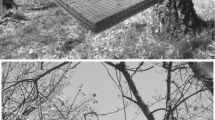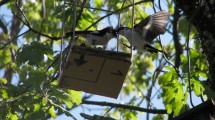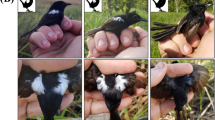Abstract
The optimal mating system is rarely the same for males and females—whereas males usually benefit from attracting additional females to the territory, this could incur costs for the resident female. Females should therefore prevent prospecting females from settling on the territory. We studied the male and female behavioral and hormonal responses to simulated female territorial intrusions in free-living bluethroats during the pre-laying period. In the study population, polygyny occurs with potential fitness costs for the resident female. We recorded different aspects of aggressive behavior before and after presentation of a live female decoy and playback of female song. These behaviors were compared with a set of intrusions using a male decoy. At the end of a trial, the birds were captured, and blood samples were analyzed for androstenedione, testosterone, estradiol and corticosterone. During the pre-intrusion period, none of the females were observed. Females generally responded strongly to the female decoy by increased flight rate, vocalizations, and by conspicuous perching. Nearly half of the males displayed to the female decoy but never while the resident female was present. We suggest that resident female aggression in bluethroats prevents courtship by her mate and signals her mating status to the female intruder. Female aggression could therefore prevent additional females to settle on the territory and shape the mating system. Females that responded with song had higher levels of estradiol. These findings suggest that estradiol may support aggression in breeding female birds.



Similar content being viewed by others
References
Amundsen T, Pärn H (2006) Female coloration: review of functional and nonfunctional hypotheses. In: Hill GE, McGraw KJ (eds) Bird coloration, vol 2. Function and evolution. Harvard Univ. Press, Cambridge, MA, pp 280–345
Amundsen T, Forsgren E, Hansen LTT (1997) On the function of female ornaments: male bluethroats prefer colorful females. Proc R Soc B 264:1579–1586
Balthazart J, Ball GF (1998) New insights into the regulation and function of brain estrogen synthase (aromatase). Trends Neurosci 21:243–249
Bennet PM, Owens IPF (2002) Evolutionary ecology of birds: life histories, mating systems, and extinction. Oxford University Press, Oxford
Breiehagen T, Slagsvold T (1988) Male polyterritoriality and female-female aggression in pied flycatchers Ficedula hypoleuca. Anim Behav 36:604–606
Cristol DA, Johnsen TS (1994) Spring arrival, aggression and testosterone in female red-winged blackbirds (Agelaius phoeniceus). Auk 111:210–214
Darwin C (1871) The descent of man and selection in relation to sex. John Murray, London
Dawkins R, Krebs JR (1979) Arms races between and within species. Proc R Soc B 205:489–511
de Ridder E, Pinxten R, Mees V, Eens M (2002) Short- and long-term effects of male-like concentrations of testosterone on female European starlings (Sturnus vulgaris). Auk 119:487–497
Dunn PO, Hannon SJ (1991) Intraspecific competition and the maintenance of monogamy in tree swallows. Behav Ecol 2:258–266
Elekonich MM (2000) Female song sparrow, Melospiza melodia, response to simulated conspecific and heterospecific intrusion across three seasons. Anim Behav 59:551–557
Elekonich MM, Wingfield JC (2000) Seasonality and hormonal control of territorial aggression in female song sparrows (Passeriformes: Emberizidae: Melospiza melodia). Ethology 106:493–510
Geslin T (2002) Territorialité en périodes de reproduction et d’hivernage chez la Gorgebleue à miroir (Luscinia svecica L.). PhD thesis, Université de Rennes I
Geslin T, Chastel O, Eybert MC (2004) Sex-specific patterns in body condition and testosterone level changes in a territorial migratory bird: the Bluethroat Luscinia svecica. Ibis 146:632–641
Glickman SE, Frank LG, Davidson JM, Smith ER, Siiteri PK (1987) Androstenedione may organize or activate sex-reversed traits in female spotted hyenas. Proc Natl Acad Sci USA 84:3444–3447
Grisham W, Arnold AP (1995) A direct comparison of the masculinizing effects of testosterone, androstenedione, estrogen, and progesterone on the development of the zebra finch song system. J Neurobiol 26:163–170
Gwinner E, Rödl T, Schwabl H (1994) Pair territoriality of wintering stonechats: behavior, function and hormones. Behav Ecol Sociobiol 34:321–327
Hannon SJ, Wingfield JC (1990) Endocrine correlates of territoriality, breeding stage, and body molt in free-living willow ptarmigan of both sexes. Can J Zool 68:2130–2134
Hau M, Stoddard ST, Soma KK (2004) Territorial aggression and hormones during the non-breeding season in a tropical bird. Horm Behav 45:40–49
Holm S (1979) A simple sequentially rejective multiple test procedure. Scand J Statist 6:65–70
Hothorn T, Hornik K (2006) exactRankTests: exact distributions for rank and permutation tests. R package version 0.8–15
Hunt KE, Wingfield JC (2004) Effect of estradiol implants on reproductive behavior of female Lapland longspurs (Calcarius lapponicus). Gen Comp Endocrinol 137:248–262
Hurly TA, Robertson RJ (1984) Aggressive and territorial behavior in female red-winged blackbirds. Can J Zool 62:148–153
Irwin RE (1994) The evolution of plumage dichromatism in the New World blackbirds: social selection on female brightness. Am Nat 144:890–907
Jawor JM, Gray N, Beall SM, Breitwisch R (2004) Multiple ornaments correlate with aspects of condition and behavior in female northern cardinals, Cardinalis cardinalis. Anim Behav 67:875–882
Johnsen A, Lifjeld JT (2003) Ecological constraints on extra-pair paternity in the bluethroat. Oecologia 136:476–483
Jones IL, Hunter FM (1999) Experimental evidence for mutual inter- and intrasexual selection favouring a crested auklet ornament. Anim Behav 57:521–528
Kempenaers B (1995) Polygyny in the blue tit: intra-sexual and inter-sexual conflicts. Anim Behav 49:1047–1064
Ketterson ED, Nolan Jr V, Casto C, Buerkle E, Clotfelter J, Grindstaff JL, Jones KJ, Lipar JL, McNabb FMA, Neudorf DL, Parker-Renga I, Schoech SJ, Snajdr E (2001) Testosterone, phenotype and fitness: a research program in evolutionary behavioral endocrinology. In: Avian Endocrinology. Narosa Publishing House, New Delhi, pp 19–38
Kroodsma DE, Bayers BE, Goodale E, Johnson S, Liu W (2001) Pseudoreplication in playback experiments, revisited a decade later. Anim Behav 61:1029–1033
Langmore NE (2000) Why do female birds sing? In: Animal Signals. Tapir Academic Press, Trondheim, pp 317–327
Langmore NE, Cockrem JF, Candy EJ (2002) Competition for male reproductive investment elevates testosterone levels in female dunnocks, Prunella modularis. Proc R Soc B 269:2473–2478
Lazarus J, Crook JH (1973) The effects of luteinizing hormone, estrogen and ovariectomy on agonistic behavior of female Quelea quelea. Anim Behav 21:49–60
Levin RN, Wingfield JC (1992) The hormonal control of territorial aggression in tropical birds. Ornis Scand 23:284–291
Ligon JD (1999) The evolution of avian breeding systems. Oxford University Press, Oxford
Mays HL, Hopper KR (2004) Differential responses of yellow-breasted chats, Icteria virens, to male and female conspecific model presentations. Anim Behav 67:21–26
McGregor PK, Catchpole CK, Dabelsteen T, Falls JB, Fusani L, Gerhardt HC, Gilbert F, Horn AG, Klump GM, Kroodsma DE, Lambrechts MM, McComb KE, Nelson DA, Pepperberg IM, Ratcliffe L, Searcy WA, Weary DM (1992) Design of playback experiments: the Thornbridge Hall NATO ARW Consensus. In: McGregor PK (ed) Playback and studies of animal communication. Plenum Press, New York, pp 1–9
Mundry R, Fischer J (1998) Use of statistical programs for nonparametric tests of small samples often leads to incorrect P values: examples from Animal Behavior. Anim Behav 56:256–259
Navara KJ, Siefferman LM, Hill GE, Mendonca MT (2006) Yolk androgens vary inversely to maternal androgens in Eastern Bluebirds: an experimental study. Funct Ecol 20:449–456
Owens IPF, Burke T, Thompson DBA (1994) Extraordinary sex-roles in the Eurasian dotterel: female mating arenas, female-female competition, and female mate choice. Am Nat 144:76–100
Peiponen VA (1960) Verhaltensstudien am Blaukehlchen (Luscinia s. svecica). Ornis Fenn 38:69–83
Pinxten R, Eens M (1990) Polygyny in the European starling: effect on female reproductive success. Anim Behav 40:1035–1047
R Development Core Team (2006) R: A language and environment for statistical computing. In. R Foundation for Statistical Computing
Rohde PA, Johnsen A, Lifjeld JT (1999) Parental care and sexual selection in the Bluethroat, Luscinia s. svecica: A field-experimental test of the differential allocation hypothesis. Ethology 105:651–663
Romero LM, Romero RC (2002) Corticosterone responses in wild birds: The importance of rapid initial sampling. Condor 104:129–135
Rutkowska J, Cichon M, Puerta M, Gil D (2005) Negative effects of elevated testosterone on female fecundity in zebra finches. Horm Behav 47:585–591
Sandell MI (1998) Female aggression and the maintenance of monogamy: female behavior predicts male mating status in European starlings. Proc R Soc B 265:1307–1311
Schlinger BA (1997) Sex steroids and their actions on the birdsong system. J Neurobiol 33:619–631
Schlinger BA (1998) Sexual differentiation of avian brain and behavior: Current views on gonadal hormone-dependent and independent mechanisms. Annu Rev Physiol 60:407–429
Schlinger BA, Callard GV (1990) Aromatization mediates aggressive behavior in quail. Gen Comp Endocrinol 79:39–53
Searcy WA (1988) Do female Red-winged Blackbirds limit their own breeding densities? Ecology 69:85–95
Sheldon BC (1993) Sexually transmitted disease in birds: occurrence and evolutionary significance. Phil Trans R Soc B 339:491–497
Sheldon BC (1994) Male phenotype, fertility, and the pursuit of extra-pair copulations by female birds. Proc R Soc Lond, B Biol Sci 257:25–30
Slagsvold T (1993) Female-female aggression and monogamy in great tits Parus major. Ornis Scand 24:155–158
Slagsvold T, Lifjeld JT (1994) Polygyny in birds: the role of competition between females for male parental care. Am Nat 143:59–94
Smiseth PT, Amundsen T (1995) Female Bluethroats (Luscinia s svecica) regularly visit territories of extrapair males before egg laying. Auk 112:1049–1053
Smiseth PT, Amundsen T (2000) Does female plumage coloration signal parental quality? A male removal experiment with the bluethroat (Luscinia s. svecica). Behav Ecol Sociobiol 47:205–212
Smith HG, Sandell MI (2005) The starling mating system as an outcome of the sexual conflict. Evol Ecol 19:151–165
Sorjonen J, Merilä J (2000) Response of male Bluethroats Luscinia svecica to song playback: evidence of territorial function of song and song flights. Ornis Fenn 77:43–47
Staub NL, DeBeer M (1997) The role of androgens in female vertebrates. Gen Comp Endocrinol 108:1–24
Svensson L (1984) Identification guide to European passerines. Lars Svensson, Stockholm
Temeles EJ (1994) The role of neighbours in territorial systems: when are they “dear enemies”? Anim Behav 47:339–350
Trail PW (1990) Why should lek-breeders be monomorphic. Evolution 44:1837–1852
Trivers R (1972) Parental investment and sexual selection. In: Sexual selection and the descent of man. Heinemann, London, pp 136–179
Veiga JP (1992) Why are house sparrows predominantly monogamous - a test of hypotheses. Anim Behav 43:361–370
Voigt C, Goymann W (2007) Sex-role reversal is reflected in the brain of African black coucals (Centropus grillii). Dev Neurobiol 67:1560–1573
Weichel K, Schwager G, Heid P, Guttinger HR, Pesch A (1986) Sex-differences in plasma steroid concentrations and singing behavior during ontogeny in canaries (Serinus canaria). Ethology 73:281–294
Wingfield JC (1985) Short-term changes in plasma levels of hormones during establishment and defense of a breeding territory in male song sparrows, Melospiza melodia. Horm Behav 19:174–187
Wingfield JC (1994) Hormone-behavior interaction and mating systems in male and female birds. In: The Differences between the Sexes. Cambridge University Press, Cambridge, pp 303–330
Wingfield JC, Farner DS (1975) Determination of five steroids in avian plasma by radioimmunoassay and competitive protein binding. Steroids 26:311–327
Wingfield JC, Farner DS (1993) Endocrinology of reproduction in wild species. In: Avian biology IX. Academic Press, New York, pp 163–327
Wingfield JC, Monk D (1992) Control and context of year-round territorial aggression in the nonmigratory song sparrow Zonotrichia melodia morphna. Ornis Scand 23:298–303
Wingfield JC, Silverin B (2002) Ecophysiological studies of hormone-behavior relations in birds. In: Hormones, brain and behavior. Academic, San Diego, pp 587–647
Wingfield JC, Lynn SE, Soma KK (2001) Avoiding the ‘costs’ of testosterone: Ecological bases of hormone-behavior interactions. Brain Behav Evol 57:239–251
Wittenberger JF, Tilson RL (1980) The evolution of monogamy: hypotheses and evidence. Ann Rev Ecolog Syst 11:197–232
Yasukawa K, Searcy WA (1982) Aggression in female Red-Winged Blackbirds: a strategy to ensure male parental investment. Behav Ecol Sociobiol 11:13–17
Acknowledgements
We thank Roger Dahl, Roar Rismark, Dave Showler and the whole Lifjeld laboratory for dedicated support in the field, and Ivar Herfindal, Christophe Pélabon and two anonymous referees for valuable comments on the manuscript. We thank Arild Johnsen and Jan Lifjeld for sharing with us valuable information on polygyny levels and field observations of female aggression. The STI experiment was approved by the Norwegian Animal Research Authority. Financial support was provided by Norwegian Research Council.
Author information
Authors and Affiliations
Corresponding author
Additional information
Communicated by J. Graves.
Rights and permissions
About this article
Cite this article
Pärn, H., Lindström, K.M., Sandell, M. et al. Female aggressive response and hormonal correlates—an intrusion experiment in a free-living passerine. Behav Ecol Sociobiol 62, 1665–1677 (2008). https://doi.org/10.1007/s00265-008-0595-3
Received:
Revised:
Accepted:
Published:
Issue Date:
DOI: https://doi.org/10.1007/s00265-008-0595-3




